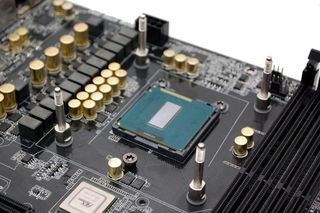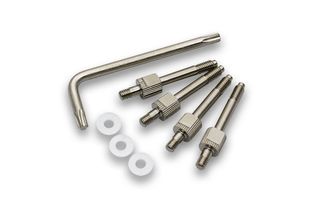EK Water Blocks Removes CPU Heat Spreader for Better Cooling of Ivy Bridge Chips
EK Water Blocks has released a cheap kit that allows users of existing Supremacy CPU blocks to remove the IHS and let the water block make direct contact with the CPU die.

Since the launch of Intel's Ivy Bridge, many enthusiast users have been a little annoyed at Intel. While in the past, Intel used to always solder the CPU die to the IHS (Integrated Heat Spreader), with the 3rd generation of Core series processors Intel has decided to fill the cavity between the ISH and the die with TIM (Thermal Interface Material). While this wouldn't affect most novice users, enthusiasts can be rather annoyed at this, because as a result, there is even more thermal separation between the CPU die and the chosen heatsink. The problem is that the CPU core will run at significantly higher temperatures than if it were to be soldered. Meanwhile, enthusiasts' biggest nuisance is the lack of thermal headroom for overclocking.
EK Water Blocks, however, has decided to do something to solve this issue the scary way. EK's solution is to simply remove the IHS so that the coolers can make direct contact with the CPU die, which should deliver amazingly good temperatures. The product line will be an add-on that will be called the EK-Supremacy PreciseMount Add-on. The PreciseMount would be an add-on that would only support the Supremacy lineup of water blocks.
Now this may sound like a lot to swallow, and an expensive add-on, but the truth is that it is just a set of screws that are a bit shorter so that the Supremacy water blocks would make direct contact with the CPU die.
Obviously, anybody willing to try this will already be aware of the risks. EK Water Blocks mentions that "this product is not for the faint of heart!" Also note that the kit would not work on any previous generation Core series processors, as the Arrandale, Clarkdale, and Sandy Bridge CPU's IHS's are all soldered to the CPU die, making removal anywhere from difficult to impossible without damaging the CPU irreversibly.

Now the least scary part is its price; the add-on costs only $5.04. Yes, that's right, just five dollars and four cents. Furthermore, it is already available in EK Water Block's online shop here.
Contact Us for News Tips, Corrections and Feedback
Stay on the Cutting Edge
Join the experts who read Tom's Hardware for the inside track on enthusiast PC tech news — and have for over 25 years. We'll send breaking news and in-depth reviews of CPUs, GPUs, AI, maker hardware and more straight to your inbox.
Niels Broekhuijsen is a Contributing Writer for Tom's Hardware US. He reviews cases, water cooling and pc builds.
-
eklipz330 "EK Water Blocks has released a cheap kit that allows users of existing Supremacy CPU blocks to remove the IHS and let the water block make direct contact with the CPU die."Reply
NO. it DOESN'T 'ALLOW' you to remove the IHS. smh. i thought it was a kit that helped you remove it easily. i was interested in it until i realized this was just about freakin screws. -
warezme How is this scary or new? Back in the age of the Athlon FX and Pentium (heatburst) processors, that is how you connected your heatsink to the CPU, directly to the die. You had to make sure the paste was spread evenly and thinly across the die with a credit card and removed the plastic thingy off your huge copper heatsink with downward facing fan. It was an art to keep the heavy heatsink flat against the die without cracking it from to much pressure. As far as I'm concerned Intel can quit trying to make thier own solution and leave the die bare. I prefer bareback on my chips.Reply -
nforce4max I've done this my self but on much older builds and there is a risk of cracking the die especially for IB. For those who want to keep the ihs but need improvements use liquid metal alloy compound that is liquid at room temp.Reply -
willard nforce4maxI've done this my self but on much older builds and there is a risk of cracking the die especially for IB. For those who want to keep the ihs but need improvements use liquid metal alloy compound that is liquid at room temp.Common misconception that you can get noticeably better thermal results from using a more expensive paste. There is about 5C difference between the best paste and worst paste, and anything that's at least as good as Arctic Silver 5 will be within one or two degrees of the top.Reply
It's better, but it's not enough to actually buy you any more headroom. -
blazorthon warezmeHow is this scary or new? Back in the age of the Athlon FX and Pentium (heatburst) processors, that is how you connected your heatsink to the CPU, directly to the die. You had to make sure the paste was spread evenly and thinly across the die with a credit card and removed the plastic thingy off your huge copper heatsink with downward facing fan. It was an art to keep the heavy heatsink flat against the die without cracking it from to much pressure. As far as I'm concerned Intel can quit trying to make thier own solution and leave the die bare. I prefer bareback on my chips.Reply
Not always. All P4 systems with an LGA 775 P4 that I've seen use an IHS. -
blazorthon willardCommon misconception that you can get noticeably better thermal results from using a more expensive paste. There is about 5C difference between the best paste and worst paste, and anything that's at least as good as Arctic Silver 5 will be within one or two degrees of the top.It's better, but it's not enough to actually buy you any more headroom.Reply
That is wrong. The paste used by Intel is utter garbage. Using even a decent past such as AC5 can improve heat transfer by around 20% according to tests done earlier (links to which are found in Tom's original Ivy Bridge launch article). -
InvalidError warezmeHow is this scary or new? Back in the age of the Athlon FX and Pentium (heatburst) processors, that is how you connected your heatsink to the CPU, directly to the die.Humm, no.Reply
The dies on early Pentiums were mounted on the back of a ceramic slab to which pins were attached so the HSF was making contact with the CPU's packaging/substrate. This arrangement has rather high thermal resistance from die to heatsink.
When Intel went with FC-BGA, they introduced Slot-1 and AMD introduced Slot-A where the CPU ships with HSF bolted to the CPU+cache PCB.
The P3 is the only Intel chip I remember where end-users had to put their HSF directly on the exposed CPU die. Every other desktop Intel CPU after that (s370/P3) had the IHS. -
matt_b We shouldn't even have to resort to something like this. Why Intel has invested over the years all the money and R&D for their process of IHS and die attachment, and then go to TIM out of nowhere? Don't understand it and shame on Intel for doing this nonsense.Reply
On another note, I've seen someone do this using a highly-conductive compound and lose about 20*C off of an OC already touching 80* C. That alone proved to me Intel's path moving to TIM and ditching their excellent flux-less solder method was the wrong direction.
Most Popular


